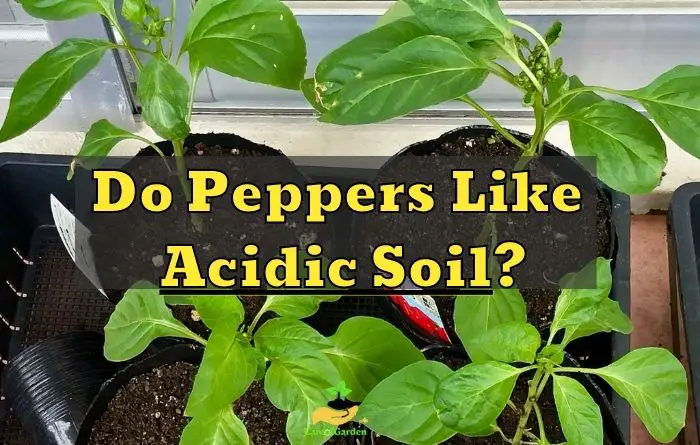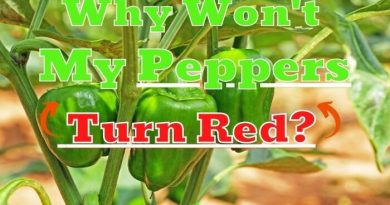Do Peppers Like Acidic Soil? (Quick Answer)
When it comes to growing peppers, soil is a crucial factor that can significantly impact their growth and yield. Different types of peppers have varying soil preferences, so it’s important to know what type of soil your peppers prefer. Specifically, you may be wondering if peppers like acidic soil.
Peppers generally prefer slightly acidic to neutral soil conditions. While they can tolerate a slightly alkaline environment, maintaining a soil pH between 6.0 and 7.0 is ideal for optimal growth. This pH range ensures proper nutrient availability, supports healthy root development, and maximizes the productivity of pepper plants. Adjusting the soil acidity, if necessary, can be done by adding organic matter or specific soil amendments.
Soil Preferences of Pepper Plants
Acidity is measured on the pH scale, which ranges from 0 to 14. A pH of 7 is considered neutral, while anything below 7 is acidic and anything above 7 is alkaline. Some plants prefer acidic soil, while others prefer alkaline soil. So, where do peppers fall on this spectrum?
The optimal soil pH range for pepper plants typically falls between 6.0 and 7.0, which leans slightly towards the acidic to neutral side. Within this range, pepper plants thrive and flourish, enjoying the ideal conditions for growth and development.
The pH range of 6.0 to 7.0 is essential as it enables pepper plants to efficiently absorb and utilize vital nutrients such as phosphorus and magnesium. These nutrients play a vital role in supporting various aspects of plant growth and development, ensuring healthy and robust pepper plants.
It’s important to note that while the general preference for pepper plants lies within this pH range, there may be slight variations in pH requirements among different types of peppers.
However, some varieties of peppers can tolerate different pH levels as you can see in the table below:
| Pepper Plant Species | Preferred pH Range |
|---|---|
| Bell Peppers | 6.0 – 7.0 |
| Cayenne Peppers | 5.5 – 7.0 |
| Jalapeno Peppers | 5.5 – 7.5 |
| Habanero Peppers | 5.5 – 6.5 |
| Banana Peppers | 5.5 – 7.0 |
| Poblano Peppers | 6.0 – 7.0 |
| Thai Peppers | 5.5 – 6.5 |
By maintaining the appropriate soil pH, pepper plants can effectively access vital nutrients like nitrogen, phosphorus, and potassium, crucial for their vigorous growth, blooming, and fruitful production.
A well-balanced pH level is key to ensuring the health and success of pepper plants in your garden.
What pH range does pepper require at different stages of growth?
Pepper plants have specific pH preferences that can vary slightly during different stages of growth.
Here is an overview of the preferred pH range for peppers at different growth stages:
- Seed Germination and Seedling Stage: During seed germination and the early seedling stage, pepper plants prefer a slightly acidic to neutral pH range. The ideal pH for this stage is around 6.0 to 6.5. Maintaining this pH range helps ensure proper nutrient availability for seedling establishment and initial root development.
- Vegetative Growth Stage: As pepper plants enter the vegetative growth stage, they continue to thrive in slightly acidic to neutral soil conditions. The preferred pH range during this stage is typically between 6.0 and 7.0. This pH range supports healthy nutrient uptake, vigorous leaf growth, and overall plant development.
- Flowering and Fruit Development Stage: Pepper plants require optimal conditions during flowering and fruit development to achieve a bountiful harvest. The preferred pH range remains similar to the vegetative growth stage, around 6.0 to 7.0. Maintaining the appropriate pH during this stage supports proper nutrient absorption, promotes robust flower formation, and enhances fruit setting and development.
Effects of Acidic Soil on Pepper Plants
The pH of the soil profoundly impacts the growth, flowering, and fruiting of pepper plants. pH imbalances can have both positive and negative effects on their overall development.
Let’s explore how soil pH influences pepper plant growth and the potential damage caused by pH imbalances:
- Optimal pH Range: Pepper plants generally thrive in slightly acidic to neutral soil pH. Most pepper varieties prefer a pH range between 6.0 and 7.0. Within this range, nutrients are readily available for uptake, supporting healthy growth and maximizing productivity.
- Nutrient Availability: Soil pH directly affects the availability of essential nutrients for plant absorption. In excessively acidic or alkaline soil, nutrient availability can be compromised. Highly acidic soil limits access to crucial nutrients like calcium, magnesium, and phosphorus, resulting in nutrient deficiencies. Similarly, alkaline soil can hinder the solubility of micronutrients such as iron, manganese, and zinc, reducing their uptake.
- Growth and Development: Appropriate soil pH is vital for robust growth and development throughout the pepper plant’s lifecycle. Unsuitable pH levels can impede root development, leading to stunted growth, reduced leaf production, and overall plant weakness. Improper pH conditions can also hinder shoot elongation, resulting in shorter and less vigorous plants.
- Flowering and Fruit Set: Soil pH significantly influences the flowering and fruiting capabilities of pepper plants. Inadequate nutrient availability due to pH imbalances can disrupt flower formation and decrease fruit set. For instance, excessive soil acidity can cause blossom end rot, manifesting as blackened and sunken areas on fruits due to calcium deficiency.
- Disease Susceptibility: Extreme pH conditions can make pepper plants more susceptible to diseases. Acidic soils promote fungal diseases, while alkaline soils can lead to nutrient imbalances that weaken the plants’ immune system. Weakened plants are more vulnerable to pathogen attacks, impacting their overall health and yield potential.
- Yield and Fruit Quality: Proper pH management significantly affects pepper yield and fruit quality. Balanced pH levels support nutrient uptake, healthy growth, and optimal fruit development. Pepper plants grown in well-maintained pH conditions tend to produce larger, healthier fruits with better flavor, color, and texture.
Table with effects of pepper plants grown in soil that is too acidic or alkaline:
| Soil pH Level | Effects on Pepper Plants |
|---|---|
| Acidic (pH below 6.0) | – Reduced nutrient availability |
| – Stunted growth | |
| – Yellowing leaves | |
| – Increased susceptibility to pests and diseases | |
| – Poor fruit set and reduced yield | |
| Neutral (pH between 6.0 – 7.0) | – Optimal growth and nutrient absorption |
| – Healthy root development | |
| – Balanced leaf color and vigor | |
| – Improved resistance to diseases and pests | |
| Alkaline (pH above 7.0) | – Nutrient deficiencies, especially iron and manganese |
| – Chlorosis (yellowing) of leaves | |
| – Limited nutrient uptake | |
| – Reduced root development | |
| – Decreased plant vigor |
https://www.southlandorganics.com/blogs/news/the-effect-of-soil-ph-on-plants
How to Test Soil Acidity for Pepper Plants
If you want your peppers to thrive, it’s crucial to consider the pH of your soil. Soil pH directly impacts nutrient availability, and peppers prefer a slightly acidic soil with a pH between 6.0 and 6.8.
Here are the steps to test the soil acidity for your pepper plants:
- Purchase a soil testing kit that includes a pH test or pH test strips from a garden center or online retailer.
- Collect a soil sample from the area where you want to grow your pepper plants. Use a trowel to dig down about 4-6 inches and collect a small amount of soil.
- Remove any debris or rocks from the soil sample and break up any clumps.
- Mix soil sample with distilled water. For a basic soil testing kit, add distilled water to the soil sample in the container provided by the kit.
- Mix well until the soil is suspended in the water.
- Add the testing solution to the mixture and stir it well. The solution will change its color based on the acid-base level of the soil sample.
- Observe the color change. Compare the color of the solution with the color chart provided by the kit. The color change indicates the pH level of the soil.
- Record the pH level of the soil sample and compare it to the ideal pH range for pepper plants, which is between 6.0 to 7.0.
- If the pH level is too high or too low, you may need to adjust it using soil amendments.
Interpreting soil pH test results:
- pH below 6.0: Indicates acidity. If the pH is too low, you may need to consider adding lime or other amendments to raise the pH and make your soil more neutral.
- pH above 7.0: Indicates alkalinity. If the pH is too high, you may need to consider adding elemental sulfur or other acidifying agents to lower the pH and make the soil more acidic.
- pH within the optimal range: A pH between 6.0 and 7.0 is ideal for pepper plants. It indicates a slightly acidic to neutral soil, providing an optimal environment for nutrient availability and plant growth.
How to Adjust and Regulate Soil Acidity for Peppers Plants
To grow healthy peppers, you can amend it to create the ideal growing conditions for your peppers using the following methods:
Lime
Lime is the first soil amendment that I suggest you to use to raise the pH levels in acidic soils. It is readily available at any garden centers. I would recommend you to add between 5 to 10 pounds of lime 100 square feet of soil before planting peppers in the spring.
Peat Moss
Peat moss is an excellent soil amendment for peppers. It is acidic and can help lower the pH level of alkaline soil. Peat moss also enhances soil structure and water retention. I would recommend you to mix peat moss with the soil at a ratio of 1:1.
Sulfur
Sulfur is commonly used soil amendment that can lower the pH level of alkaline soil. I recommend you should use elemental sulfur, which is readily available at garden centers. Generally, 1 to 2 pounds of sulfur per 100 square feet is sufficient.
Coffee Grounds
Coffee grounds are an excellent source of nitrogen and can improve soil fertility. They are also slightly acidic and can help lower the pH level of alkaline soil. It is recommended to add coffee grounds to the soil before planting peppers. A ratio of 1:10 coffee grounds to soil is ideal.
Wood Ash
Wood ash, a good source of potassium, can improve soil fertility. It is slightly alkaline and can raise the pH of acidic soil. Adding wood ash to the soil before planting peppers is recommended, at a ratio of 1:10 wood ash to soil.
Conclusion
In summary, when it comes to growing peppers, it’s crucial to understand their soil preferences to ensure optimal growth and yield. Peppers generally prefer a slightly acidic soil with a pH range between 5.5 and 6.8.
Some varieties, such as bell peppers and banana peppers, can tolerate slightly alkaline soil with a pH range of 7.0 to 8.0. Chili peppers, jalapeño peppers, habaneros, hot peppers, cherry peppers, and mini sweet peppers prefer well-drained soil that is rich in organic matter. These peppers thrive in soil that is high in nitrogen, phosphorus, and potassium.
On the other hand, cubanelle peppers and banana peppers prefer soil that is slightly sandy and well-drained. These peppers do not tolerate soil that is too wet or heavy.




